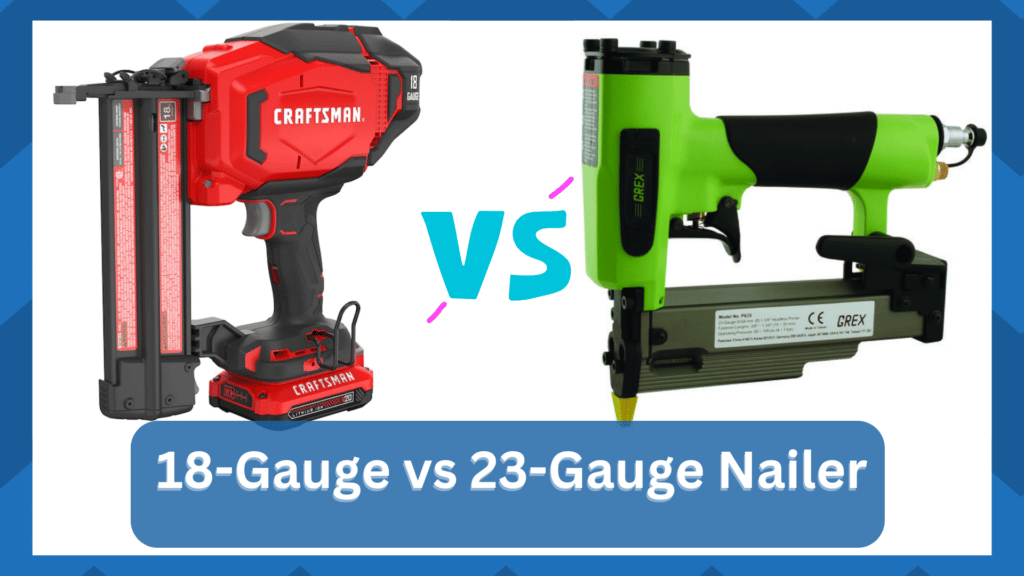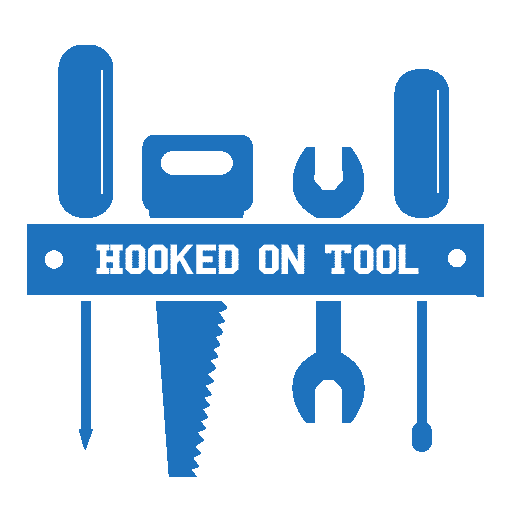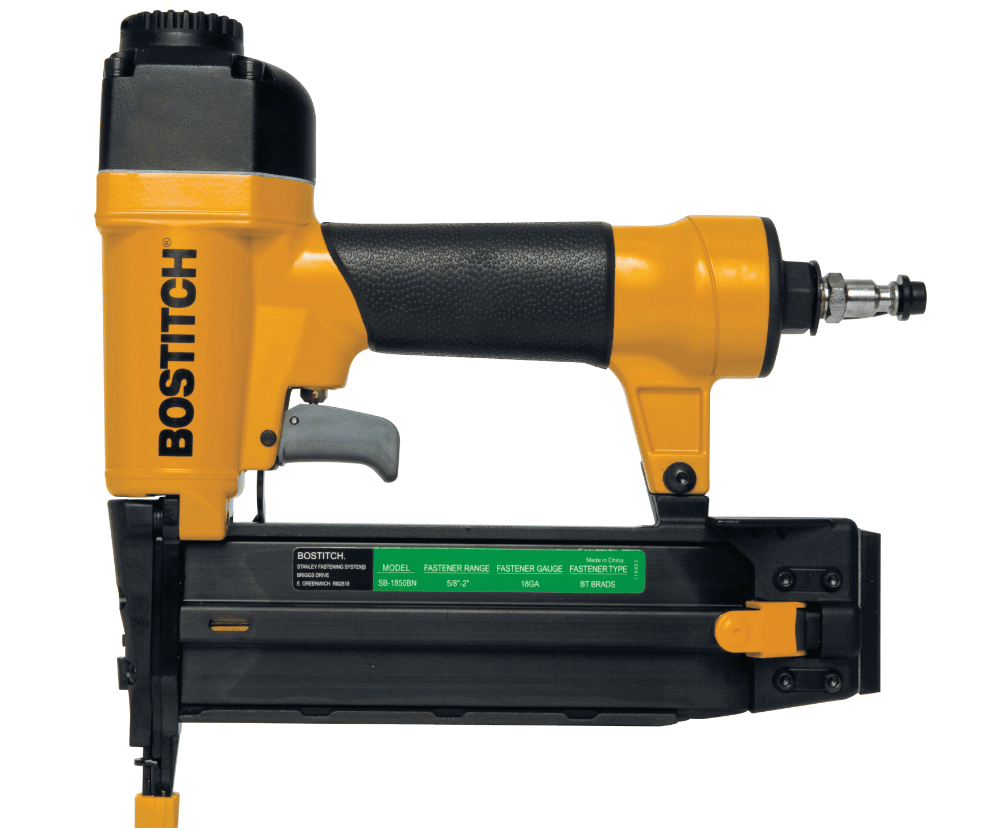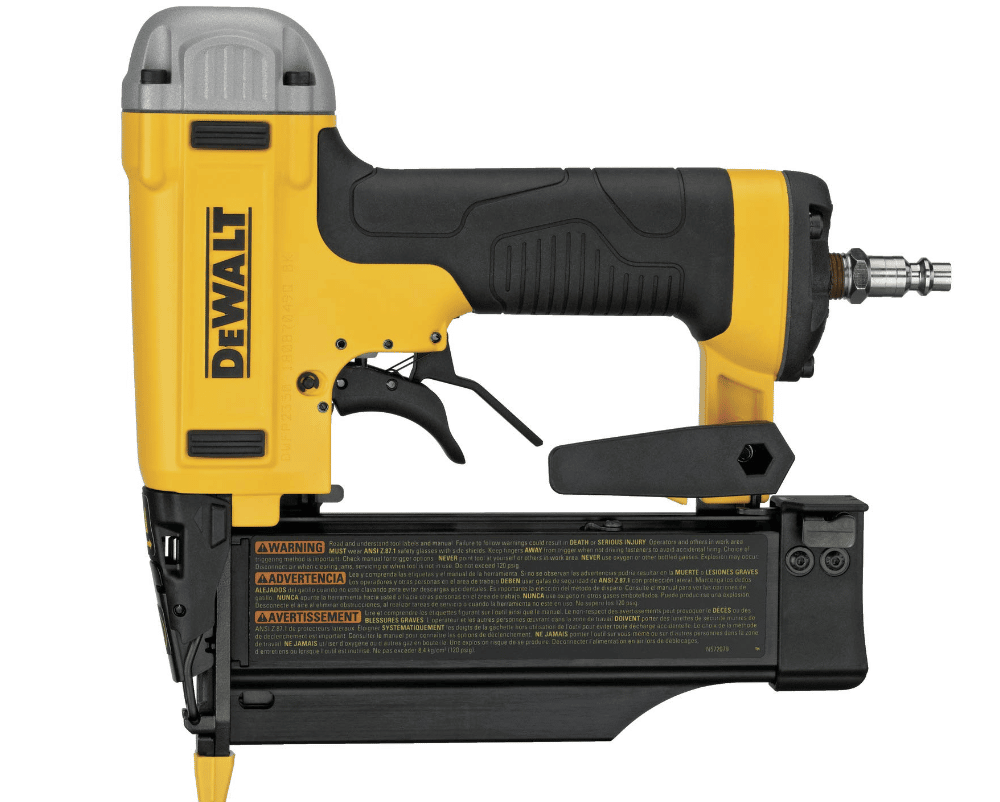
Nailing is needed widely for a applications like working with metal sheets, wooden furniture, infrastructure, and more construction jobs to ensure that you can make it work for all such nailing needs
That is certainly something cool, and you will be saving a lot of time and effort with the pressure nailer since all you need to do is press the trigger.
That will shoot a nail precisely with adequate power on the material that you might be dealing with.
Yet, there are a number of factors that you need to know about while you are picking any of these nailers to ensure that you are making the right choice that will suit your needs in the right manner.
18-Gauge VS 23-Gauge Nailer: Main Differences
It goes without saying that you will have to be a bit more careful while you are dealing with such nailers for certainty.
There are different specifications on the brad nailers that matter a lot, and a few key differences to know about the 18-gauge and 23-gauge nailers.
To choose the one suitable for your needs among these two are:
| Specifics | 18 Gauge | 23 Gauge |
| Versatility | Limited | Extensive |
| Dent | Massive | Minimal |
| Touch Up | Extensive | Limited |
| Price Point | Reasonable | Premium |
Deciding between these two options might not seem that significant, but you’ll surely struggle to manage the efficiency of your project when going with the wrong unit.
You can think of the 18 gauge option as the more robust unit that will deliver a thicker nail that can dent softer wood.
This is not desirable if you’re working to develop a cleaner finish. So, be sure to keep that in mind when working with a softer material.
You can’t really work with this option in the long run, and going with the 18-gauge option is only better when you need a more robust presence.
Similarly, the 23 gauge system will eliminate the need for the users to go through extensive touch-up routines.
This system has a minimal presence and can also be considered a micro pinner. So you won’t see any dents or any other issues after the nailing routine is completed.
It all comes down to what type of material you will be using. If you’re going to be working with a delicate material or a softer material that you don’t want to dent, going with a 23 gauge is much better.
Alternatively, if you need a more robust setup, then 18 gauge is for you.
However, if you’re stuck somewhere in the middle, most owners will suggest that you try out the 18 gauge.
That is because you can go through the touch-up routine and still make the project look good after the use of the 18 gauge.
On the other hand, you can’t really rely on a micro pinner for demanding projects. So, it will be much harder to get through the project when you don’t have a robust option.
Moreover, the 23 gauge is far more expensive than your standard 18 gauge option.
Here are some more specifics on each of these nailers to help you with a better perspective.
18 Gauge Nailer
18 Gauge nailer has 18 gauge of pressure, contrary to what the name suggests, and that is higher than the 23-gauge nailer for sure, but that is only what a basic level of the workman should know about.
The 23-gauge brad nailer is used to shoot thin nails ranging from 3/8” to 2”, and that would depend on the model of the nailer that you are getting since it can vary.
On the other hand, the 18 Gauge can work with ⅝ to 2 inches.
They will leave a bigger hole in the opening as well, and that is how you will not have to worry about splitting the thinner wood that you will have to face otherwise with the manual nailing.
You can use the for number of applications, such as stop moldings, base shoes, cove moldings, and a number of other furniture applications for smaller applications that require discreet nailing.
You can also use them for most furniture applications, such as chair rails or more, and you will have to make certain that you are using them with the right nails.
18 Gauge nailers would be the best choice for you since they are available in both cordless and pneumatic power sources and configurations to make them work for a wide range of applications.
23 Gauge Nailer
While it might feel like the 23-gauge nailers are used for some of the bigger nails, that is not true. Instead, 23-gauge nailers are used for small-headed pins.
That will be used with the better settings structure, so you are not missing out on a single thing while dealing with any of those applications that require precision and discretion at the same time.
The 23-gauge nailers are often used with glue to cover those holes that might be created with these pins, and you will have the perfection of not having to fill those holes manually later.
These nailers can be chosen with cordless or pneumatic configuration and power, so you don’t have to worry about making it work for any of the job sites.
You just have to ensure that you are picking the right gauge on the nailer that fits your needs precisely to make it all work.
It is mostly used for pinning those thin metal or wooden sheets on top of the furniture while making it work for an optimal finish, and you will get a smoother surface for any of that furniture.
You can also use it for attaching the moldings, installing beads and thin stops to different furniture, and other wooden workpieces that you might be working on.
Just be mindful of the length of the pins that you are going to be using since the nailer can pin them, but you will need to choose them based on the depth of the workpiece that you might have been dealing with.
So, instead of looking at the prices or the availability of the unit, you need to look at the material that you will be working with.
There is no point in looking at the prices as you will only be disappointed when the unit can’t last you in a demanding project.
Seeking help from the dealer will help you decide for sure whether or not a particular unit fits your requirements.
So, instead of testing out everything yourself, you need to inquire about details from a dealer.
Wrapping Up
There is no debate that finding the correct type of nailer can be hard. However, you don’t have to keep track of pointless indicators or price points to find the perfect fit.
Instead, you need to reach out to the dealer with your requirements. Every project can vary, and you need something that will last you for decades.
So, ignoring the price, you need to focus more on what type of material you’ll be using. If you’re going to be using a standard material, then going with the 18 gauge is the better idea.
It is more versatile and can get you through demanding as well as delicate projects with a bit of touch-up.
Similarly, if you are only going to be working with softer material, then going with 23 gauge is the better idea.
The thickness of the nail head is just better here, and you won’t have to deal with any dents. So, keep that in mind when you can’t seem to find the right fit.
Be sure to ask the dealer for more options as well, as you don’t have to restrict yourself to these two systems.







Looks like 23 ga is the choice in manufactured home interior trim work like around windows and doors, is it?